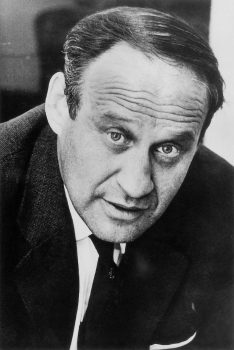Juhani Niemi on Väinö Linna
Issue 4/1980 | Archives online, Authors

Väinö Linna. Photo: WSOY
Väinö Linna fits squarely into one of the dominant patterns of twentieth century literary development in Scandinavia. Like many writers of the period, Linna came from a working class background and struggled to free himself from that environment through self-education. He had no special interest in politics but his natural leanings were moderately left-wing. He isn’t a ‘political’ writer as such, and it would be simplistic to apply labels to his views. His central interests, which directly affect his style, are a concentration on firstly, acute social observation and, secondly, social analysis. Through novels in this genre – and Linna is without doubt a master – the reader finds a world and all its influences, from the personal to the historical and economic dissected, the casings laid back, the true juxtapositions revealed.
The process can be powerful and effective and Linna’s major works Tuntematon Sotilas (‘The Unknown Soldier’, 1954, English translation 1957) and the trilogy Täällä Pohjantähden alla (‘Here beneath the North Star’, 1960-62) have struck deep into the Finnish national consciousness radically influencing the way events in recent Finnish history have been viewed by a wide audience of readers. Both works have been enormously popular: the characters have so accurately caught the Finnish personality that they have become part of the nation’s mythology.
An excerpt from ‘Here beneath the North Star’ is published here (Chapter 3, Volume II). The entire trilogy is over 1500 pages long: it is a slice of Finnish social history, covering the period from 1880 to the Second World War. The scale is large: some fifty characters have central roles, the most important being the tenant farmer Jussi Koskela and the members of the second and third generations of his family. Their world is Pentinkulma, a small provincial village. The technique is a familiar one: the writer limits his field of vision to a narrow sector and then examines the phenomena of the time by looking in detail at the everyday life of a small group. Here, massive historical changes are seen through the effect they have on the work and lives of a rural community. The main focus is on the proletariat, but the landowning classes are also depicted so as to give a truly representative picture. In turn, we see all the important aspects of 19th and 20th century thought as they operate in village life. Linna’s own sympathies, however, do not lie with idealists and visionaries, but with pioneers of few words who till their land. It is they who give us the clue to the philosophical heart of the work.
Social conflict and the growth of the organized labour movement are central issues. The roots of the conflict between owners and workers go back hundreds of years, of course, but in Finland open warfare did not break out until after the 1917 Russian Revolution. Linna’s novel is particularly concerned with the struggles of the tenant farmers and the intense social drama in which they found themselves. This excerpt describes the battles, in spring 1917, to legalize an eight-hour working day.
The main characters are Halme, a tailor, and Akseli Koskela, a tenant farmer.
The former is an idealist and a social democrat, a representative of the old humanist tradition. The writer has made him a slightly ludicrous character.
The latter, the fighting hero of the piece, becomes the leader of the union of tenant farmers. His sense of justice and the importance he attaches to the concept of solidarity give us an insight into the writer’s own views on man’s role in the tide of events. Akseli Koskela is also the central character in Linna’s dramatisation of the 1918 Civil War in Finland. In this way, Linna makes us take a fresh look at the causes and consequences of that war. The aggression and violence of the strikes that result from the demands for agricultural reforms, in which Koskela is so closely involved, are a symbol of the antagonism between the social classes and at the same time are a foreshadowing of the Civil War, a clash between the conflicting interests of the classes on a national scale.
In the third volume of the trilogy Linna’s view of historical events changes somewhat. The reforms and improvements in conditions achieved by organized labour are woven into the very structure of the book: the third generation of Koskelas have gained their independence and have become self-sufficient smallholders. Their thirst for revolution has gone. Ideology has been replaced by an enthusiasm for good husbandry and for concrete improvement in the living standards of all.
Translated by Mary Lomas
No comments for this entry yet
Leave a comment
Also by Juhani Niemi
Paradise lost - 31 March 2007
-
About the writer
Juhani Niemi (born 1947) is a literary scholar, critic and author. He lives in Hämeenlinna.
© Writers and translators. Anyone wishing to make use of material published on this website should apply to the Editors.
